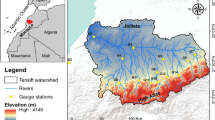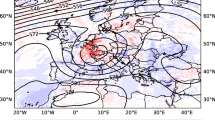Abstract
Characteristics of localized heavy rainfall events (LHREs) in South Korea are analyzed using high-resolution precipitation reanalysis data from the Korea Meteorological Administration (KMA). The LHREs, defined as summertime heavy rainfall events with 30 mm/h or more, are detected using in-situ measurements, and their spatio-temporal structures are classified into the three groups using precipitation reanalysis data. The first group is mainly composed of band-type precipitation around the central regions of South Korea (CHREs). The second group predominantly consists of LHREs in the southern regions (SHREs). The third group contains diverse and isolated rainfall events (IHREs). Each group exhibits a different rainfall persistency, diurnal cycle, and occurrence frequency. In general, CHREs peak mostly in July and have shorter time scales compared to SHREs. SHREs are more nocturnal in nature with maximum frequencies in both July and August. IHREs, which consist of 47% of total LHREs, are composed of both nocturnal rainfall events in the southern coastal regions and daytime rainfall events in the inland regions. These results suggest that LHREs in South Korea have multiple characteristics and cannot be simply explained by one or two representative mechanisms.








Similar content being viewed by others
References
Akinduko, A. A., and E. M. Mirkes.: Initialization of self-organizing maps: principal components versus random initialization. A case study. arXiv preprint arXiv:1210.5873 (2012)
Cassano, E.N., Lynch, A.H., Cassano, J.J., Koslow, M.R.: Classification of synoptic patterns in the western Arctic associated with extreme events at Barrow, Alaska, USA. Clim. Res. 30(2), 83–97 (2006)
Chang, C.P., Hou, S.C., Kuo, H.C., Chen, G.T.J.: The development of an intense east Asian summer monsoon disturbance with strong vertical coupling. Mon. Weather Rev. 126, 2692–2712 (1998)
Chen, S.-J., Lee, D.K., Tao, Z.Y., Kuo, Y.H.: Mesoscale convective system over the yellow sea–a numerical case study. Meteorog. Atmos. Phys. 70(3–4), 185–199 (1999)
Chen, T.–.C., et al.: Variation of the east Asian summer monsoon rainfall. J. Clim. 17(4), 744–762 (2004)
Choi, K.-S., Kim, B.-J.: Climatological characteristics of tropical cyclones making landfall over the Korean peninsula. J. Korean Meteorol. Soc. 43(2), 97–109 (2007)
Chu, J.-E., Hameed, S.N., Ha, K.-J.: Nonlinear, intraseasonal phases of the east Asian summer monsoon: extraction and analysis using self-organizing maps. J. Clim. 25(20), 6975–6988 (2012)
Dai, A.: Global precipitation and thunderstorm frequencies. Part II: diurnal variations. J. Clim. 14(6), 1112–1128 (2001)
Dai, A., Giorgi, F., Trenberth, K.E.: Observed and model-simulated diurnal cycles of precipitation over the contiguous United States. J. Geophys. Res. Atmos. 104(D6), 6377–6402 (1999)
Davies, D.L., Bouldin, D.W.: A cluster separation measure. IEEE Trans. Pattern Anal. Mach. Intell. 2, 224–227 (1979)
Garcı́a, H.L., González, I.M.: Self-organizing map and clustering for wastewater treatment monitoring. Eng. Appl. Artif. Intell. 17(3), 215–225 (2004)
Goudenhoofdt, E., Delobbe, L.: Evaluation of radar-gauge merging methods for quantitative precipitation estimates. Hydrol. Earth Syst. Sci. 13(2), 195–203 (2009)
Han, J.-Y., Baik, J.-J., Lee, H.: Urban impacts on precipitation. Asia-Pac. J. Atmos. Sci. 50(1), 17–30 (2014)
Hartigan, J.A., Wong, M.A.: Algorithm AS 136: a k-means clustering algorithm. J. R. Stat. Soc.: Ser. C: Appl. Stat. 28(1), 100–108 (1979)
Ho, C.-H., Kang, I.-S.: The variability of precipitation in Korea. J. Korean Meteor. Soc. 24(1), 38–48 (1988)
Hong, S.-Y.: Comparison of heavy rainfall mechanisms in Korea and the central US. J. Meteorol. Soc. Jpn. Ser. II. 82(5), 1469–1479 (2004)
Hong, S.-Y., Lee, J.-W.: Assessment of the WRF model in reproducing a flash-flood heavy rainfall event over Korea. Atmos. Res. 93(4), 818–831 (2009)
Hsu, H.-H., Zhou, T., Mastsumoto, J.: East Asian, Indochina and Western North Pacific summer monsoon - an update. Asia-Pac. J. Atmos. Sci. 50(1), 45–68 (2014)
Hwang, H.-S., Byun, H.R., Lee, S.M., Choi, K.S., Lee, J.S.: Distribution of precipitation on the Korean Peninsula associated with the weakening of tropical cyclones. J. Korean Earth Sci. Soc. 31(4), 322–334 (2010)
Jung, J.H., Suh, M.S.: Characteristics and types of the diurnal variation of hourly precipitation during rainy season over South Korea. J. Korean Meteorol. Soc. 41(4), 533–546 (2005)
Jung, I.-W., Bae, D.-H., Kim, G.: Recent trends of mean and extreme precipitation in Korea. Int. J. Climatol. 31(3), 359–370 (2011)
Kato, A., Maki, M.: Localized heavy rainfall near Zoshigaya, Tokyo, Japan on 5 August 2008 observed by X-band Polarimetric radar—preliminary analysis. Sola. 5, 89–92 (2009)
Kim, Y.-H., Baik, J.-J.: Maximum urban heat island intensity in Seoul. J. Appl. Meteorol. 41(6), 651–659 (2002)
Kim, H.-K., Seo, K.-H.: Cluster analysis of tropical cyclone tracks over the western north pacific using a self-organizing map. J. Clim. 29(10), 3731–3751 (2016)
Kohonen, T. Learning vector quantization. Self-organizing maps. Springer, Berlin, Heidelberg, 1995. 175–189
Korea Meteorological Administration, 2018: Meteorological disaster statistics. URL http://www.weather.go.kr/weather/lifenindustry/disaster_02.jspOctober 2018
Kug, J.-S., Ahn, M.-S.: Impact of urbanization on recent temperature and precipitation trends in the Korean peninsula. Asia-Pac. J. Atmos. Sci. 49(2), 151–159 (2013)
Lee, S.: The distribution of precipitation in Cheju island. Journal of the Korean Geographical Society. 34(2), 123–136 (1999)
Lee, T.-Y., Kim, Y.-H.: Heavy precipitation systems over the Korean peninsula and their classification. Asia-Pac. J. Atmos. Sci. 43(4), 367–396 (2007)
Lee, G.-H., Seo, K.-H.: Analysis of diurnal and semidiurnal cycles of precipitation over South Korea. Atmosphere. 18(4), 475–483 (2008)
Lee, D.-K., Kim, H.-R., Hong, S.-Y.: Heavy rainfall over Korea during 1980~ 1990. J. Korean Meteorol. Soc. 1(1), 32–50 (1998)
Lee, S.-S., et al.: Shift of peak in summer monsoon rainfall over Korea and its association with El Niño–Southern Oscillation. J. Geophys. Res.-Atmos. 115(D2), (2010)
Lee, J.-Y., Kwon, M.H., Yun, K.S., Min, S.K., Park, I.H., Ham, Y.G., Jin, E.K., Kim, J.H., Seo, K.H., Kim, W.M., Yim, S.Y., Yoon, J.H.: The long-term variability of Changma in the east Asian summer monsoon system: a review and revisit. Asia-Pac. J. Atmos. Sci. 53(2), 257–272 (2017)
Lim, G.-H., Kwon, H.-J.: Diurnal variation of precipitations over South Korea and its implication. Asia-Pac. J. Atmos. Sci. 34(2), 222–237 (1998)
Lim, G.-H., Suh, A.-S.: Diurnal and semidiurnal variations in the time series of 3-hourly assimilated precipitation by NASA GEOS-1. J. Clim. 13(16), 2923–2940 (2000)
Lim, Y.-K., Kim, K.-Y., Lee, H.-S.: Temporal and spatial evolution of the Asian summer monsoon in the seasonal cycle of synoptic fields. J. Clim. 15(24), 3630–3644 (2002)
Lin, X., Randall, D.A., Fowler, L.D.: Diurnal variability of the hydrologic cycle and radiative fluxes: comparisons between observations and a GCM. J. Clim. 13(23), 4159–4179 (2000)
Liu, Y., Weisberg, R.H., Mooers, C.N.K.: Performance evaluation of the self-organizing map for feature extraction. J. Geophys. Res. Oceans. 111(C5), (2006)
Liu, W., Wang, L., Chen, D., Tu, K., Ruan, C., Hu, Z.: Large-scale circulation classification and its links to observed precipitation in the eastern and central Tibetan Plateau. Clim. Dyn. 46(11–12), 3481–3497 (2016)
Martens, B., et al.: Merging weather radar observations with ground-based measurements of rainfall using an adaptive multiquadric surface fitting algorithm. J. Hydrol. 500, 84–96 (2013)
Nesbitt, S.W., Zipser, E.J.: The diurnal cycle of rainfall and convective intensity according to three years of TRMM measurements. J. Clim. 16(10), 1456–1475 (2003)
Ninomiya, K., Kobayashi, C.: Precipitation and moisture balance of the Asian summer monsoon in 1991. J. Meteorol. Soc. Jpn. Ser. II. 77(1), 77–99 (1999)
Ninomiya, K., Shibagaki, Y.: Multi-scale features of the Meiyu-Baiu front and associated precipitation systems. J. Meteorol. Soc. Jpn. Ser. II. 85, 103–122 (2007)
Nishiyama, K., Endo, S., Jinno, K., Bertacchi Uvo, C., Olsson, J., Berndtsson, R.: Identification of typical synoptic patterns causing heavy rainfall in the rainy season in Japan by a self-organizing map. Atmos. Res. 83(2–4), 185–200 (2007)
Qian, W., Kang, H.-S., Lee, D.-K.: Distribution of seasonal rainfall in the east Asian monsoon region. Theor. Appl. Climatol. 73(3–4), 151–168 (2002)
Roh, J.-W., Kim, K.-Y., Jhun, J.-G.: Decadal changes in the physical mechanisms of the seasonal cycle of summertime precipitation variability in Korea. J. Geophys. Res. Atmos. 117(D7), (2012a)
Roh, J.-W., Lee, Y.H., Nam, J.E., Chung, K.Y.: Diurnal variations of summertime precipitation in South Korea in 2009 using precipitation reanalysis data. SOLA. 8, 155–159 (2012b)
Rousi, E., et al.: Representing teleconnection patterns over Europe: a comparison of SOM and PCA methods. Atmos. Res. 152, 123–137 (2015)
Seo, K.-H., Son, J.-H., Lee, J.-Y.: A new look at Changma. Atmosphere. 21(1), 109–121 (2011)
Shibagaki, Y., Ninomiya, K.: Multi-scale interaction process associated with development of a sub-synoptic-scale depression on the Meiyu-Baiu frontal zone. J. Meteorol. Soc. Jpn. 83, 219–236 (2005)
Siemon, H. P., and A. Ultsch. Kohonen Networks on Transputers: Implementation and Animation. International Neural Network Conference. Springer, Dordrecht, 1990
Sohn, B.J., Ryu, G.H., Song, H.J., Ou, M.L.: Characteristic features of warm-type rain producing heavy rainfall over the Korean Peninsula inferred from TRMM measurements. Mon. Weather Rev. 141(11), 3873–3888 (2013)
Son, S.-W., Lee, D.-K.: A numerical study on the evolution of a mesoscale cyclone and associated low-level jet along the east Asian monsoon front. J. Korean Meteorol. Soc. 4(2), 65–82 (2001)
Song, H.-J., Sohn, B.-J.: Two heavy rainfall types over the Korean peninsula in the humid east Asian summer environment: a satellite observation study. Mon. Weather Rev. 143(1), 363–382 (2015)
Takayabu, Y.N.: Spectral representation of rain profiles and diurnal variations observed with TRMM PR over the equatorial area. Geophys. Res. Lett. 29(12), 25–21 (2002)
Tochimoto, E., Kawano, T.: Development process of Baiu frontal depression. SOLA. 8, 009–012 (2012)
Ultsch, A.: Kohonen's self organizing feature maps for exploratory data analysis. Proc. INNC90. 305–308 (1990)
Vesanto, J., et al.: SOM Toolbox for Matlab 5. Helsinki University of Technology, Finland (2000): 109
Wallace, J.M.: Diurnal variations in precipitation and thunderstorm frequency over the conterminous United States. Mon. Weather Rev. 103(5), 406–419 (1975)
Zhou, T., et al.: Summer precipitation frequency, intensity, and diurnal cycle over China: a comparison of satellite data with rain gauge observations. J. Clim. 21(16), 3997–4010 (2008)
Acknowledgements
The authors thank anonymous reviewers for their constructive comments and suggestions that substantially improved the manuscript. Funding for this research was provided by the office of the Research and Development for Numerical Weather Prediction and Earthquake Services of the Korea Meteorological Administration (KMA-2018-00720) and the National Research Foundation of Korea (NRF-2018R1A5A1024958).
Author information
Authors and Affiliations
Corresponding author
Additional information
Responsible Editor: Kyong-Hwan Seo.
Publisher’s Note
Springer Nature remains neutral with regard to jurisdictional claims in published maps and institutional affiliations.
Rights and permissions
About this article
Cite this article
Jo, E., Park, C., Son, SW. et al. Classification of Localized Heavy Rainfall Events in South Korea. Asia-Pacific J Atmos Sci 56, 77–88 (2020). https://doi.org/10.1007/s13143-019-00128-7
Received:
Revised:
Accepted:
Published:
Issue Date:
DOI: https://doi.org/10.1007/s13143-019-00128-7




